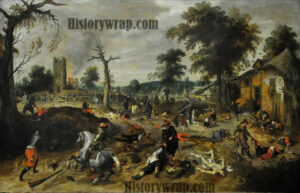Beginning of Conflicts

In European history, the Thirty Years’ War (1618–48) was a string of conflicts involving several countries due to territorial, dynastic, religious, and commercial rivalry. Most of Europe was on the scene of its catastrophic campaigns and wars, and by the time it came to a close in 1648 with the Treaty of Westphalia, the continent’s geography had been irreparably altered.
Following is a brief discussion of the Thirty Years’ War. For a thorough discussion, see Europe, History of the Thirty Years War.
The war is generally believed to have started in 1618 when the Protestant nobles of both Bohemia and Austria rebelled against the future Holy Roman emperor Ferdinand II’s attempt to impose Roman Catholic absolutism on his domains, even though the conflicts that led to it broke out a few years earlier. After a five-year battle, Ferdinand was victorious. King Christian IV of Denmark saw a chance in 1625 to add vital territory in Germany to make up for the Baltic provinces he had earlier lost to Sweden. The Danish dominance in Europe was stopped by the Christian’s defeat and the Peace of Lübeck in 1629. Still, when Sweden’s Gustav II Adolf completed a four-year war with Poland, he invaded Germany and won over many German princes to his anti-Roman Catholic, anti-imperial cause.
The war expanded in the meantime due to the competing powers’ political aspirations. To further its objectives, Poland attacked Russia and installed a dictatorship in Moscow under the leadership of Wadysaw, Poland’s future king. Poland had been brought in as a Baltic power that Sweden desired. The Russo-Polish Peace of Polyanov terminated Poland’s claim to the tsarist throne in 1634. Still, it also allowed Poland to continue hostilities with Sweden, its Baltic archrival that was now firmly entangled in Germany. Three denominations fought for supremacy in this region of Europe: Roman Catholicism, Lutheranism, and Calvinism. Princes and prelates requested assistance from foreign nations, which led to a Gordian web of relationships. Overall, the conflict was between the Protestant cities and principalities that relied on the main anti-Catholic forces of Sweden and the United Netherlands, which had finally freed themselves from the rule of Spain after an 80-year battle, and the Roman Catholic and Habsburg Holy Roman Empire. The contest between France and the Habsburgs of the Empire and Spain, who had been striving to forge an anti-French alliance cordon, was a parallel conflict.
The towns and principalities of Germany were the main theatres of all these sporadic battles, and they suffered greatly. Many of the opposing armies of the Thirty Years’ War were made up of mercenaries, and many were unable to collect their wages. They were forced to seek supplies in the countryside; as a result, starting the “wolf strategy” that came to characterize this conflict. Cities, towns, villages, and farmland were destroyed as both sides’ forces pillaged the area as they marched. The balance of power in Europe had drastically shifted by the time the warring countries ultimately convened in the German region of Westphalia to put an end to the slaughter. Not only had Spain lost the Netherlands, but also its hegemonic position in western Europe. Now, the dominant Western power was France. Stockholm was in charge of the Baltic. The United Netherlands was acknowledged as a sovereign nation. The Holy Roman Empire’s constituent countries were given complete sovereignty. The fundamental framework of modern Europe as a community of independent nations was constructed, irrevocably abandoning the ancient idea of a Roman Catholic kingdom of Europe, ruled spiritually by a pope and temporally by an emperor.

Before the great wars of the 20th century, the Thirty Years’ War (1618–1688) was the most devastating conflict in Europe. There are many theories about why the conflict started, but none frequently evaluate the advantages of competing ideas or explicitly state what assumptions underlie them. Older German writing characterized the war as a fight starting in the Holy Roman Empire but merging with wars elsewhere, in contrast to anglophone research, which typically puts it within a larger struggle against Spanish Habsburg power. Others, viewing the conflict as the climax of a “General Crisis of the Seventeenth Century” caused by social, economic, or environmental issues, focus more on structural causes. A resurgence of the idea that it was a religious conflict or a “state-building war” associated with the change from medieval to the modern political organization has occurred more recently. This essay examines these methods’ effectiveness as historical justifications before proposing a substitute. It names the challenge of describing the conflict as the main impediment to elucidating its causes. The Thirty Years’ War was essentially a confrontation for the political and theological structure of the Empire, although being connected to other wars in Europe. It wasn’t inescapable nor the outcome of unbridgeable theological differences. Instead, the conflict inside the Empire coincided with a political and dynastic crisis within the Habsburg monarchy, undermining the emperor’s authority to address long-standing constitutional issues.
The first modern conflict was the Thirty Years’ War.
The first of the wars that would follow broke out in Northern Europe in 1618, setting off three decades of bloodshed, starvation, and illness that ravaged the region and wiped out most of its people. The Thirty Years’ War, as it is now known, lasted until 1648. The subsequent intellectual revolution established the groundwork for the law of war and signaled the start of new world order. However, the incident has had an impact throughout history in other, lesser-known ways. The beginning of humanitarian work as we know it today was characterized by St. Vincent de Paul’s charity endeavors.
Additionally, there are numerous similarities between this earlier prolonged conflict and its contemporary counterparts, such as those in Yemen, South Sudan, Nigeria, and Somalia, where it has been challenging to find long-lasting political solutions. The Thirty Years’ War significantly impacted Europe’s political environment and social structure. And this instability, rather than a direct military confrontation, caused the most significant loss of life. The Thirty Years’ War, which lasted almost four centuries, tells us how long combat may cause starvation and be disastrous for the population. By Senior Policy Advisor at the ICRC Pascal Daudin.
How can the Thirty Years’ War help us today?
Historians mostly concur about what the Thirty Years’ War tells us today. Some contend that it was the first instance of total war because of its significant, long-lasting, and far-reaching consequences on modern civilization. It was a current war, with low-intensity battles and conventional combat that had little in common with medieval chivalry or the 18th-century “Lace Wars.”
Political comparisons have been made between the conflicts of today and the religious wars of the 17th century. The belief held in certain circles, at least, creative comparisons are encouraged by the idea that Westphalian sovereignty is eroding. For instance, Zbigniew Brzezinski referred to the Middle East conflict as “a thirty-year war” a few years ago. Richard Haas also compared the 2011 suicide of a teenage street seller from Tunisia to the Defenestration of Prague.
As resources become more scarce, the effects of climate change manifest themselves, and national borders are redrawn, some economists, like Michael T. Klare, assert that we may probably witness a return to the instability – and political and military warfare – of the mid-17th century. Strategists also believe that a deal in the Westphalian tradition may help some regions achieve long-term peace.
Although this is a compelling political parallel, our environment today is very different. The world’s structure and system of governance have evolved. Comparing two occurrences that are so far in time is never wise. Similarity does not imply comparability. People who use historical examples to explain current events are sometimes charged with having a hidden political agenda and distorting reality to fit their argument.
FAQ’S
- What happened in the 30 years war?
The Thirty Years’ War was a 17th-century religious conflict fought primarily in central Europe. It remains one of the longest and most brutal wars in human history, with more than 8 million casualties resulting from military battles as well as from the famine and disease caused by the conflict.
- What was the main cause of the 30 years war?
The primary cause of the Thirty Years’ War was the actions of Emperor Ferdinand II in forcing the protestants into Catholicism. The war ended with the Peace of Westphalia, a treaty that laid boundaries for European countries and recognized subsequent territorial sovereignty throughout Europe.
- What countries were in the 30 Years war?
It developed into a political struggle between the Catholic Habsburgs of the Holy Roman Empire (Austria, most of the German princes and occasionally Spain). They were opposed by Denmark, Sweden, Catholic France and the Protestant princes of Germany. The war ended with the Peace of Westphalia in 1648.
- Why did France join the 30 years war?
France had both political and religious motivations for becoming involved in the 30 years war. The 30 years war was an effort to stabilize the power of the Holy Roman Empire and to suppress the growing anti Catholic movement of the Protestant Reformation.
- What ended the 30 years war?



